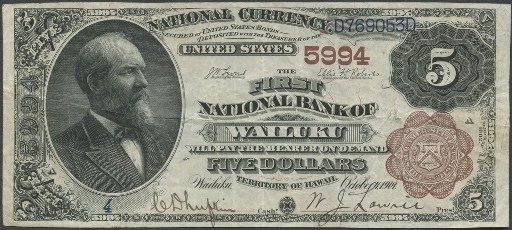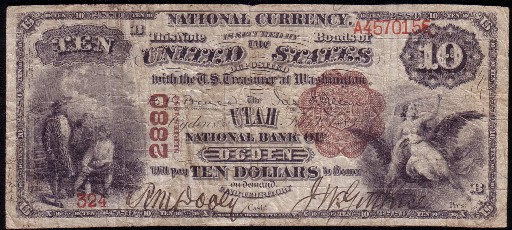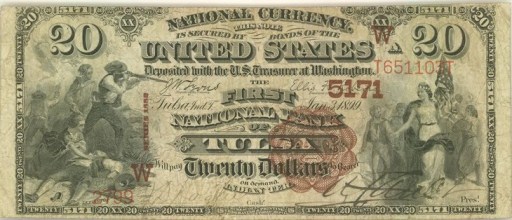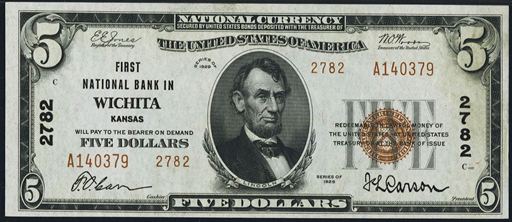The Stillwater National Bank Of Stillwater
The Stillwater National Bank Of Stillwater in Oklahoma printed $602,070 dollars worth of national currency. That is a high amount, but condition and serial numbers can make otherwise common currency from this bank quite valuable. This national bank opened in 1900 and stopped printing money in 1935, which equals a 36 year printing period. That is a fairly normal lifespan for a national bank. During its life, The Stillwater National Bank Of Stillwater issued 9 different types and denominations of national currency. We have examples of the types listed below. Your bank note should look similar. Just the bank name will be different. For the record, The Stillwater National Bank Of Stillwater was located in Payne County. It was assigned charter number 5347.
We buy all national currency. Please call or email us for a quote. Sales@AntiqueMoney.com
The Stillwater National Bank Of Stillwater in Oklahoma issued 1,700 sheets of $5 1882 territorial brown back national bank notes. A total sheet output in the lows 1,000s is a great sign that you own a very rare bank note. 1882 five dollar territorial brown backs are the lifeblood of the territorial collecting community. They were issued by virtually every territory (with exception of Alaska, Nebraska, and Porto Rico). A total of 109 national banks printed $5 brown back territorials. There are around 120 notes known to exist. That is a pretty high survival rate. Ironically though, the fact that lots of these exist is part of the reason that they are so collectible. More than one collector can reasonably try to put together a set. Ultra-rarities are always expensive, but often times they end up as outliers to collections. 1882 five dollar brown backs have always been popular. When you combine that with the appeal of a territorial, then you have a real winner. You can contact us to learn the true value and rarity of your note. In the meantime, take the number of sheets printed and multiply it by four, that will give you the total number of 1882 $5 territorials issued.
Series of 1882 $5 Territorial Brown Back
The Stillwater National Bank Of Stillwater printed 1,240 sheets of $10 1882 territorial brown back national bank notes. A total sheet output in the lows 1,000s is a great sign that you own a very rare bank note. The ten dollar 1882 territorial brown back was printed by more than 200 national banks, and more than 200 pieces are known to exist today. That number tends to go up by a handful each year as more are discovered. Often times the $10 territorial was the first and lowest denomination a bank received. About a dozen #1 specimens are held by collectors today, and there are probably many more still held by descendants of early pioneer bankers. Territorial bank notes are the cream of the crop when it comes to national bank notes. Most are at least rare and some can be very valuable. As always, the exact value is still based on bank of issue and condition. Something ugly from Oklahoma might only be worth $3,000, but other examples could be worth well over $10,000.
Series of 1882 $10 Territorial Brown Back
The Stillwater National Bank Of Stillwater also printed 1,240 sheets of $20 1882 territorial brown back national bank notes. That number also represents the total number of twenty dollar bills printed for the type. Whether you have a ten or a twenty dollar territorial brown back, you should work with an expert to establish the value. Twenty dollar notes from this series were only printed at the rate of one to three compared to tens, but sadly, $20 1882 brown backs really don’t command a premium for their extra rarity. Only around fifty are known to exist today.
Series of 1882 $20 Territorial Brown Back
The Stillwater National Bank Of Stillwater also printed 2,790 sheets of $5 1882 blue seal national bank notes. That is a pretty standard sheet output number for these issues. Most of the value is going to be in the condition. 1882 $5 blue seal bank notes were issued by some national banks in The United States. While these are a somewhat rarer issue, they just aren’t especially popular with collectors. With exception of some minor differences, they look exactly like the earlier brown back series. Most collectors would prefer the brown back notes. With that said, some 1882 blue seals can still be worth thousands of dollars. So don’t just assume that what you have is automatically common.
1882 Blue Seal $5 National Bank Note
The Stillwater National Bank Of Stillwater also printed 1,981 sheets of $10 1882 blue seal national bank notes. 1882 blue seals are traditionally not the most popular national bank notes. However, when we are talking about such a low print number, these become much more desirable. All of these notes say series of 1882 but they were actually printed between 1908 and 1921. So they aren’t quite as old as the dates might suggest. There is also a date on these notes that is between 1888 and 1901. That date is written in cursive text and it represents when the bank was chartered or re-chartered. Some of the so called 1882 value back notes have a chance to be really rare. Most of the earlier notes that say 1882-1908 on the back are likely going to be relatively common. The designs are exactly the same on the front. Each has a blue seal and charter number.
1882 Blue Seal $10 National Bank Note
The Stillwater National Bank Of Stillwater also printed 1,981 sheets of $20 1882 blue seal national bank notes. That is the same number of sheets as the ten dollar denomination. You don’t have to multiply by three to get the exact number of notes issued though. There was only one twenty dollar bill per sheet. As with any national bank note, the exact value is still based on the condition, serial number, and bank of issue.
1882 Blue Seal $20 National Bank Note
The Stillwater National Bank Of Stillwater also printed 10,949 sheets of $5 1902 blue seal national bank notes. Once a bank prints more than 10,000 sheets of blue seals it becomes very difficult for those notes to be rare. Ben Harrison is on the front of all 1902 $5 blue seal bank notes. This happens to be the smallest denomination issued for the 1902 series. Each note is complete with a blue seal and blue charter number. Despite saying series of 1902, these were actually issued by national banks between 1908 and 1928. There are two different types of blue seals. The first type is called a date back and it has “1902-1908” written on the back of the bill. The other type is called a plain back; it does not have the date stamps on the back of the bill. The values for these notes range widely based on condition and the bank of issue.
1902 $5 Blue Seal National Bank Note
The Stillwater National Bank Of Stillwater also printed 3,274 sheets of Type1 1929 $5 national bank notes. That is a pretty typical sheet output for a national bank during the small size era. Every 1929 $5 bill has a portrait of Abraham Lincoln on it. This is also the lowest denomination of small size national currency that any bank issued. All serial numbers end with the letter A and start with a letter between A and F. Remember that you can take the total number of sheets printed and multiply it by six get to the actual number of bank notes printed for this denomination. All small size national bank notes were printed on sheets of six.
Series of 1929 Type1 $5 National Bank Note
The Stillwater National Bank Of Stillwater also printed 6,804 individual notes from the type2 1929 $5 national bank note series. This is a pretty typical print run for type2 national bank notes. Values will be across the board based on demand. This was an easy and popular denomination for national banks. Five dollars could buy a lot of different things back in 1929 and the early 1930s. 1929 type2 five dollar bank notes are available in quantities today. However, some notes can be extremely rare. The exact value all depends on the bank of issue and condition. Contact us and we would be happy to give a free appraisal.
Series of 1929 Type2 $5 National Bank Note



